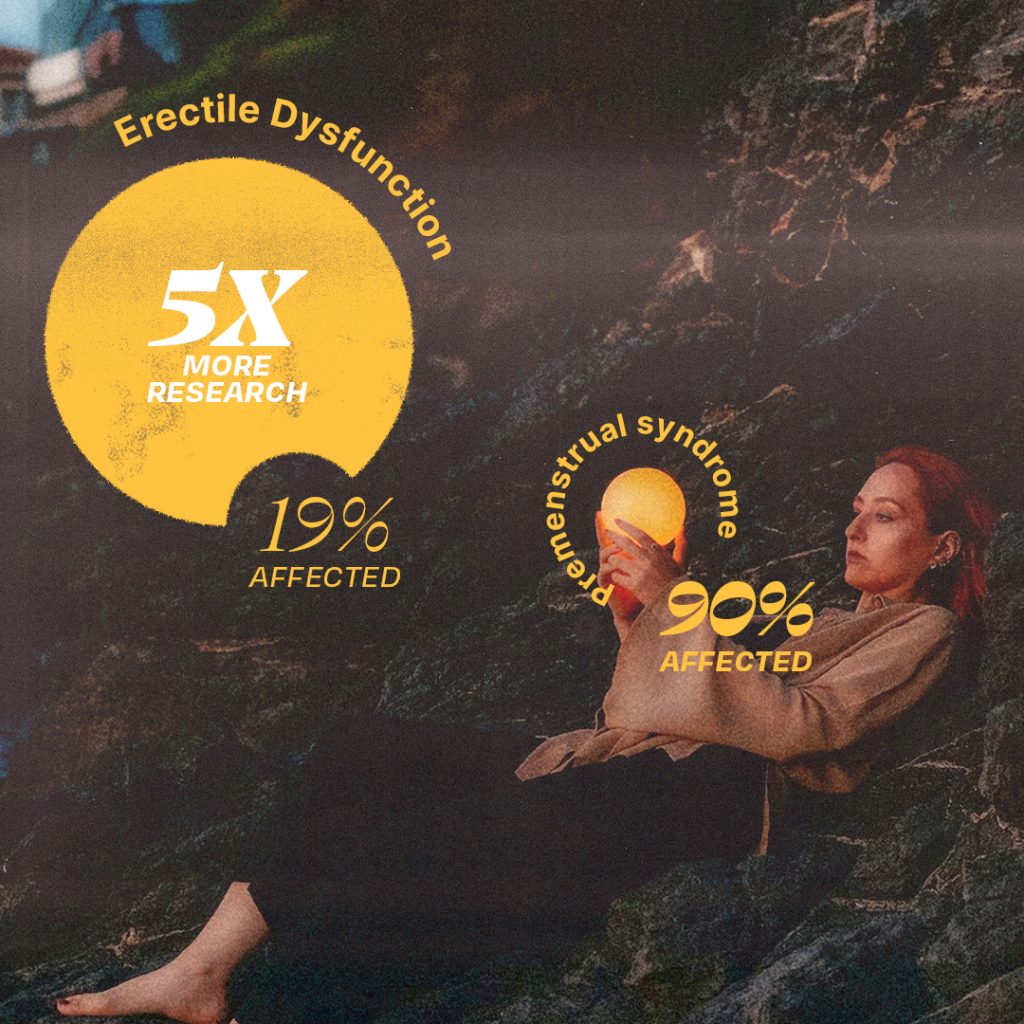First published on Marketing Week
1. The UK’s Gender Health Gap
As we move seamlessly from October’s Menopause and Breast Cancer Awareness Months’ activities into November’s festive marketing flurry, it’s time to take a break from what to some may have felt like four weeks of female health overload. Or is it?

Shock Fact
As reported by the House of Lords, the UK’s gender health gap is the worst out of all G20 countries. With limited insight into female-specific conditions as well as how non-gender-specific conditions affect them, women end up chronically misunderstood, mistreated and misdiagnosed in Britain. (Case in point: they are 50 per cent more likely than men to be misdiagnosed following a heart attack and more likely than men to die from heart attacks.)
While it is ridiculously low levels of funding into female-focused medical research that is mostly to blame for stats like that (according to McKinsey, just 5% of healthcare research and innovation today is invested in female-specific conditions, and there is five times more research into erectile dysfunction, which affects 19% of men, than into premenstrual syndrome, which affects 90% of women), it’s also true that the need to improve women’s female-specific health literacy can’t be understated.
And health literacy is one area where healthcare marketers can make a difference. “The school education system is so lacking concerning female health – marketers and femtech businesses have a huge opportunity to pick things up, to educate consumers about their health and wellbeing. For example, users come to our app for a specific need, period tracking, but we then take the opportunity, using storytelling, to help those visitors understand more about their bodies and their broader health,” says Joëlle Barthel, director of brand marketing at Flo.
2. Health Literacy & Stigma
Ending stigma around some of women’s female-specific health areas is also vital – whether via big-hitting creative campaigns that move the needle or simply creating valuable, safe spaces for women to explore what they’re going through with others privately, gaining a sense of reassurance that even a GP often can’t give you.
“Women want those ‘over the garden fence’ moments to access the support they’re looking for. Within women’s online groups we see 14 times more search volume than in men’s, suggesting that they’re seeking empowerment from each other and yearning for a sense of community. That’s hard for healthcare professionals and governments to replicate, but it’s something healthcare marketers can definitely help with,” says Tamara Rogers, CMO at Haleon, GSK’s consumer healthcare spin-off.
“Google is a database of intent…. seven out of 10 health-related searches around “Is this normal?” relate to women’s bodies. They are voraciously seeking answers,” Rogers adds, suggesting that creating a mechanism where women’s hunger for answers meets trustworthy research data is a slam dunk for healthcare marketers, “We have a real opportunity – we can put research data or information out there that people can take as truth. Educational pieces that the Google search engine can find and surface as helpful facts. Doing so enables us to play a very active role in health literacy and education.”

3. Stepping Up To The Plate
As healthcare marketers step up to the plate in terms of helping to improve health literacy among women, the hope is that women will also feel increasingly ‘seen’ by big pharma (an area where there is much improvement still to be made – while women are the “power buyers” of healthcare, controlling about 80% of healthcare spend, according to a Yankelovich Monitor report from 2015 as many as two-thirds of women said they didn’t feel understood by healthcare marketers.)

As healthcare marketers step up to the plate in terms of helping to improve health literacy among women, the hope is that women will also feel increasingly ‘seen’ by big pharma (an area where there is much improvement still to be made – while women are the “power buyers” of healthcare, controlling about 80% of healthcare spend, according to a Yankelovich Monitor report from 2015 as many as two-thirds of women said they didn’t feel understood by healthcare marketers.)
Happily, there are concerted steps to better listen to, support and provide for female consumers being taken. “There is definitely progress, but there’s still a big white space in terms of owning the conversation and driving change,” says Barthel. Patricia Corsi, chief marketing, digital and information officer at Bayer Consumer Health, the company behind the groundbreaking ‘Vagina Academy’ initiative for thrush treatment from Canesten, acknowledges the potential for further improvements when she says with humility,
“We have an immense responsibility. And what are we doing with this responsibility that we’ve been granted? That is the question I continually ask myself. With work like Canesten, I feel we’re owning obligations, showing up. And it’s good for the business; it’s good for our customers. It’s a good cycle of growth for everyone.”
4. But What About The Barriers?
Few would argue with that, but what about the barriers that can quickly derail positive intention setting in healthcare? Addressing bias (which even lurks in algorithms – on Facebook, ads about erectile dysfunction are widely accepted by the platform, while those related to breastfeeding or post-partum comfort are regularly rejected due to concerns about ‘adult content’) and improving female representation at the senior leadership level are two prominent areas for focus.
The obvious rationale for the latter being the more healthcare companies elevate female leaders inside their businesses, the better positioned they are to become genuinely female consumer-focused. “Intellectually, anyone can understand most things. But you need to ‘feel’ it….. If you don’t have people in the C-suite who have that perspective, a female perspective, you’re effectively continuing to treat women’s health issues as ‘niche,” says Corsi frankly.
As ever in this column, it’s clear that the significant socio-economic gender disparities we see around us – in this case regarding health outcomes for women – are the result of years and layers of social, economic (and political) discrimination. But again, while marketing communications alone won’t close the gender health gap, creatively tailored messaging that recognises women’s difference from men – and increases their engagement with health issues, conditions and products – can only help. Our industry has tremendous power.

As Corsi puts it, “I truly believe that good marketing is truth well told. And we have a lot of good truths to tell. It’s about access to health education, really thinking about the role of the brands in crafting compelling narratives that can drive change, break down taboos, improve access to education and distil complex topics into accessible ones. These are all areas we can do something about and deliver disproportionate impact as marketers.”

Helen James in the managing director of agency CPB London and the co-founder of Creative Equals/Business, a leadership programme and community for women in the creative industries. She is focused on ensuring more women in marketing and creative roles are able to thrive at the top.




